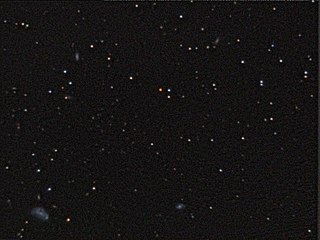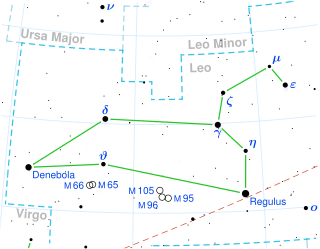| Observation data Epoch J2000 Equinox J2000 | |
|---|---|
| Constellation | Leo |
| Right ascension | 10h 56m 28.92087s[1] |
| Declination | +07° 00′ 53.0033″[1] |
| Apparent magnitude (V) | 13.507[2] |
| Characteristics | |
| Spectral type | M6V[3] |
| Apparent magnitude (J) | 7.1[4] |
| Apparent magnitude (K) | 6.1[4] |
| U−B color index | +1.165[2] |
| B−V color index | +2.034[2] |
| Variable type | UV Ceti[5] |
| Astrometry | |
| Radial velocity (Rv) | +19±1[6] km/s |
| Proper motion (μ) | RA: −3,866.338 mas/yr[1] Dec.: −2,699.215 mas/yr[1] |
| Parallax (π) | 415.1794 ± 0.0684 mas[1] |
| Distance | 7.856 ± 0.001 ly (2.4086 ± 0.0004 pc) |
| Absolute magnitude (MV) | 16.614[7] |
| Details | |
| Mass | 0.110±0.003[8] M☉ |
| Radius | 0.144±0.004[8] R☉ |
| Luminosity | 0.00106 ± 0.00002[8] L☉ |
| Habitable zone inner limit | 0.024[9] AU |
| Habitable zone outer limit | 0.052[9] AU |
| Surface gravity (log g) | 5.5[10] cgs |
| Temperature | 2,749+44 −41[8] K |
| Metallicity [Fe/H] | +0.25[11] dex |
| Rotation | 2.704±0.003 d[12] |
| Rotational velocity (v sin i) | 2.9±0.8[13] km/s |
| Age | 0.1-1.5[14] Gyr |
| Other designations | |
| Database references | |
| SIMBAD | data |
Wolf 359 is shown near the ecliptic in the southern region of Leo. | |
Wolf 359 is a red dwarf star located in the constellation Leo, near the ecliptic. At a distance of 7.86 light-years (2.41 parsecs) from Earth, it has an apparent magnitude of 13.54 and can only be seen with a large telescope. Wolf 359 is one of the nearest stars to the Sun with only the Alpha Centauri system (including Proxima Centauri), Barnard's Star, and the brown dwarfs Luhman 16 (WISE 1049-5319) and WISE 0855−0714 known to be closer. Its proximity to Earth has led to its mention in several works of fiction.[16]
Wolf 359 is one of the faintest and least-massive nearby stars known. At the light-emitting layer called the photosphere, it has a temperature of ~2,800 K, low enough for chemical compounds to form and survive. The absorption lines of compounds such as water and titanium(II) oxide have been observed in its spectrum.[17] The star's surface has a magnetic field hundreds of times as strong as that of the Sun, generated by its thorough internal convection. As a result of this significant magnetic activity, Wolf 359 is a flare star that can undergo sudden and great increases in luminosity, which can persist for several minutes. These flares emit strong bursts of X-ray and gamma ray radiation that have been observed by space telescopes. It is a relatively young star with an estimated age of less than a billion years. No planetary companions for Wolf 359 have been confirmed so far, though there is one unverified candidate, and as yet no debris disks have been found.[14]
- ^ a b c d Cite error: The named reference
dr3was invoked but never defined (see the help page). - ^ a b c Cite error: The named reference
aj137_5was invoked but never defined (see the help page). - ^ Cite error: The named reference
todd1994was invoked but never defined (see the help page). - ^ a b Cite error: The named reference
2masswas invoked but never defined (see the help page). - ^ Cite error: The named reference
ass95_2was invoked but never defined (see the help page). - ^ Cite error: The named reference
apj583was invoked but never defined (see the help page). - ^ Cite error: The named reference
houdebine2019was invoked but never defined (see the help page). - ^ a b c d Cite error: The named reference
pineda2021was invoked but never defined (see the help page). - ^ a b Cite error: The named reference
aaa555_A104was invoked but never defined (see the help page). - ^ Cite error: The named reference
aaa439_3was invoked but never defined (see the help page). - ^ Cite error: The named reference
mann2015was invoked but never defined (see the help page). - ^ Cite error: The named reference
da2019was invoked but never defined (see the help page). - ^ Cite error: The named reference
lafarga2021was invoked but never defined (see the help page). - ^ a b Cite error: The named reference
Bowens-Rubin2023was invoked but never defined (see the help page). - ^ Cite error: The named reference
SIMBADwas invoked but never defined (see the help page). - ^ Weir, Andy (2022). Project Hail Mary. London: Penguin Books. ISBN 978-1-5291-5746-8.
- ^ Cite error: The named reference
apj596_1was invoked but never defined (see the help page).

